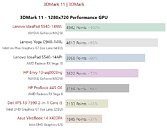Tuesday, October 1st 2019

Intel Iris Plus Graphics G7 iGPU Beats AMD RX Vega 10: Benchmarks
Intel is taking big strides forward with its Gen11 integrated graphics architecture. Its performance-configured variant, the Intel Iris Plus Graphics G7, featured in the Core i7-1065G7 "Ice Lake" processor, is found to beat AMD Radeon RX Vega 10 iGPU, found in the Ryzen 7 2700U processor ("Raven Ridge"), by as much as 16 percent in 3DMark 11, a staggering 23 percent in 3DMark FireStrike 1080p. Notebook Check put the two iGPUs through these, and a few game tests to derive an initial verdict that Intel's iGPU has caught up with AMD's RX Vega 10. AMD has since updated its iGPU incrementally with the "Picasso" silicon, providing it with higher clock speeds and updated display and multimedia engines.
The machines tested here are the Lenovo Ideapad S540-14API for the AMD chip, and Lenovo Yoga C940-14IIL with the i7-1065G7. The Iris Plus G7 packs 64 Gen11 execution units, while the Radeon RX Vega 10 has 640 stream processors based on the "Vega" architecture. Over in the gaming performance, and we see the Intel iGPU 2 percent faster than the RX Vega 10 at Bioshock Infinite at 1080p, 12 percent slower at Dota 2 Reborn 1080p, and 8 percent faster at XPlane 11.11.
Source:
Notebook Check
The machines tested here are the Lenovo Ideapad S540-14API for the AMD chip, and Lenovo Yoga C940-14IIL with the i7-1065G7. The Iris Plus G7 packs 64 Gen11 execution units, while the Radeon RX Vega 10 has 640 stream processors based on the "Vega" architecture. Over in the gaming performance, and we see the Intel iGPU 2 percent faster than the RX Vega 10 at Bioshock Infinite at 1080p, 12 percent slower at Dota 2 Reborn 1080p, and 8 percent faster at XPlane 11.11.





34 Comments on Intel Iris Plus Graphics G7 iGPU Beats AMD RX Vega 10: Benchmarks
Why didn't you demand tests of Vega 64 on GDDR5 instead of HBM2? :-)
The only way to extract more out of a IGP is something like a MXM card or a HBM2 stack of chips on top of the chip. Otherwise your always bound to much slower DDR(4) memory which is often castrated in speeds and timings, due to cost / space / TDP savings.
If people want ultraportable graphics performance they buy either a Ryzen-U APU or move on up to the MX150/MX250 options. If they don't want graphics performance they'll be buying something with a ULV Intel processor that likely has a severely downclocked GT2 implementation, starved of performance by the TDP limits of a thin ultraportable. The minute your requirements extend to bulkier laptops, there are dGPUs with vastly superior performance at competitive prices compared to the more expensive higher-end Intel CPUs with Iris graphics, so the Iris graphics niche is tiny and borderline irrelevant.
What Intel really need to do is focus on making their GT2 IGPs perform well with low memory bandwidth and no embedded cache.
That's what AMD did with Raven Ridge; Vega 8 with even slower RAM is acceptable for low-def mainstream gaming as long as the TDP isn't too restrictive (20W gets 90% of the performance available, 15W models struggle once the STAPM threshold is reached). Once you add faster, dual-channel RAM, even the MX150 looks unnecessary - and that's just talking about an 18-month old, lower-end Raven Ridge model. The newer Picasso Ryzen 7 3700U on 12nm is even more efficient and that gets decent performance out of just 15W.
And it's not like you could magically test Ice Lake-U with desktop DDR4 anyway. In fact, most (if not all) Ice Lake-U notebooks shown to date are ultrabooks with soldered RAM.I wouldn't call that "a problem". It's a property.
In laptops performance is always adjusted for power consumption target or cooling limitations. There's a huge variance in performance on the same components.
Laptop users are more feature-oriented and they tolerate this (and the fact that one should read a review of the particular - not similar - laptop).
Desktop users are more performance-oriented.